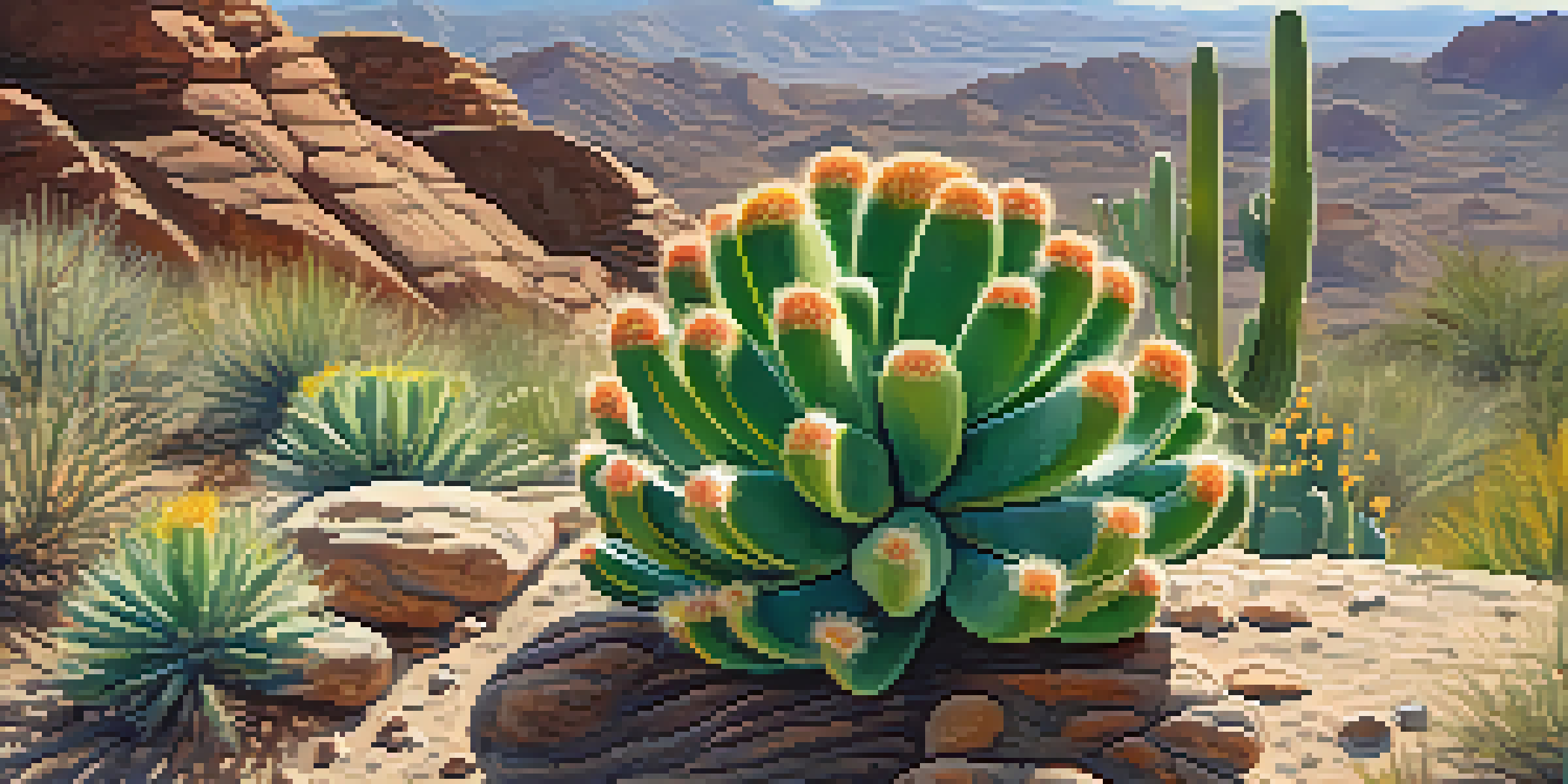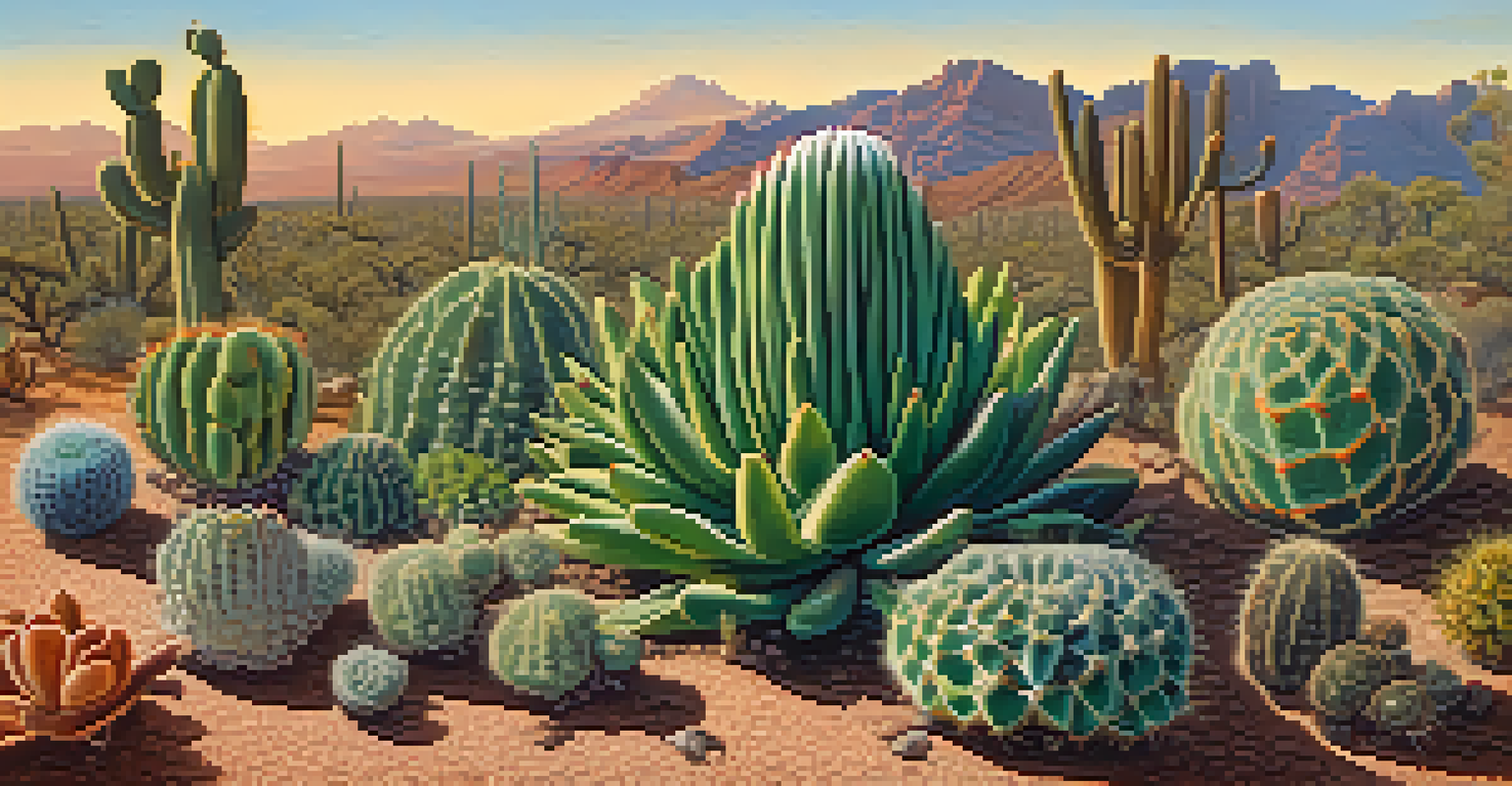Peyote in Indigenous Healing: A Sacred Connection to Nature

Understanding Peyote: More Than Just a Plant
Peyote is a small, spineless cactus native to the southwestern United States and Mexico. For many Indigenous peoples, this plant is not just a part of nature; it's a sacred tool used in spiritual and healing practices. The active compound in peyote, mescaline, induces altered states of consciousness, allowing users to experience deep introspection and spiritual connections.
The plant is a teacher; it reveals the depths of our consciousness and connects us to the universe.
This cactus has been used for thousands of years, often in ceremonial contexts, to foster healing, guidance, and connection to the divine. The rituals surrounding peyote are deeply rooted in tradition, with each ceremony designed to promote wellness and communal bonding. For many, peyote represents a bridge between the physical and spiritual worlds.
Understanding peyote's significance requires acknowledging the cultural and historical contexts in which it is used. The respect and reverence shown toward this plant reflect Indigenous peoples' profound relationship with nature, emphasizing the importance of sustainable practices and the sacredness of the natural world.
The Role of Peyote in Indigenous Healing Practices
In many Indigenous cultures, peyote is integral to healing ceremonies, often referred to as 'peyote meetings.' These gatherings serve as a space for community members to share their struggles and seek guidance. The healing process facilitated by peyote is holistic, addressing not just physical ailments but also emotional and spiritual wounds.

During these ceremonies, participants consume peyote in a safe, controlled environment, guided by experienced leaders known as 'roadmen.' They help participants navigate their experiences, ensuring that everyone feels supported. This communal aspect fosters a sense of belonging and connection, reinforcing the idea that healing is a collective journey.
Peyote's Sacred Role in Healing
Peyote is a vital component of Indigenous healing practices, promoting holistic wellness through community ceremonies.
Moreover, the insights gained from peyote experiences often lead individuals to make positive changes in their lives. Many find clarity regarding personal issues, relationships, or even life paths. This transformative potential underscores why peyote is cherished as a vital component of Indigenous healing practices.
Cultural Significance of Peyote in Indigenous Traditions
Peyote holds a central place in various Indigenous cultures, particularly among the Huichol, Navajo, and Lakota peoples. For these communities, the cactus symbolizes not just a spiritual guide but also a connection to their ancestors and the earth. This deep cultural significance is reflected in stories, songs, and rituals passed down through generations.
In every walk with nature one receives far more than he seeks.
The rituals surrounding peyote use are steeped in symbolism and meaning, often involving elaborate ceremonies that honor the plant and its spirit. These practices serve to reinforce community bonds and educate younger generations about their cultural heritage. The teachings associated with peyote are not merely about the plant itself, but about the interconnectedness of all life.
By understanding the cultural significance of peyote, we begin to appreciate the broader worldview of Indigenous peoples, where nature is revered and seen as a source of wisdom. This perspective challenges modern attitudes towards nature, advocating for respect and stewardship instead of exploitation.
Challenges Facing Indigenous Practices with Peyote
Despite its sacred status, peyote faces numerous challenges today, primarily due to environmental issues and legal restrictions. Overharvesting and habitat loss threaten the cactus's survival, putting traditional practices at risk. Many Indigenous communities are deeply concerned about the sustainability of peyote and are advocating for conservation efforts.
Legal challenges also loom large, as the use of peyote is often restricted to certain groups, leading to tensions between Indigenous rights and governmental regulations. Many tribes are fighting to protect their right to use peyote in spiritual practices without fear of legal repercussions. This struggle highlights the ongoing need for respect and recognition of Indigenous sovereignty.
Cultural Significance of Peyote
The cactus symbolizes deep spiritual connections and reinforces community bonds in various Indigenous cultures.
The fight for peyote's survival and the rights to its use is not just about a plant; it symbolizes a broader struggle for Indigenous identity, culture, and autonomy. The resilience of Indigenous communities in protecting their traditions is a testament to their deep-rooted connection to nature and spirituality.
Peyote and the Modern Spirituality Movement
In recent years, interest in peyote has surged beyond Indigenous communities, influencing the modern spirituality movement. Many individuals are drawn to peyote for its potential to enhance self-awareness and provide transformative experiences. However, this growing interest raises ethical questions about cultural appropriation and the commodification of Indigenous practices.
While some people seek to incorporate peyote into their spiritual journeys, it's crucial to approach these practices with respect and sensitivity. Understanding the cultural context and the sacredness of peyote is essential for anyone looking to engage with it outside Indigenous traditions. This respect helps prevent the exploitation of indigenous knowledge and promotes genuine appreciation.
The intersection of peyote and modern spirituality presents an opportunity for dialogue and education. By fostering understanding between Indigenous peoples and those interested in peyote, we can encourage respectful practices that honor the plant's sacred nature and the cultures that have long revered it.
The Environmental Impact of Peyote Use
Peyote's significance extends beyond its spiritual use; it also highlights important environmental issues. The overharvesting of this cactus, driven by increased demand, poses a serious risk to its populations in the wild. This situation is exacerbated by climate change, which threatens the natural habitats where peyote grows.
Sustainable practices are crucial for preserving peyote populations and ensuring that Indigenous communities can continue their traditions. Many tribes advocate for conservation efforts that not only protect the cactus but also promote biodiversity and ecological balance. By taking care of peyote, we’re also taking care of the broader ecosystem.
Challenges to Peyote Sustainability
Environmental threats and legal restrictions pose significant challenges to the preservation of peyote and its cultural practices.
This environmental perspective connects back to the core values of Indigenous healing, where respect for nature is paramount. Understanding the ecological significance of peyote encourages us to think more deeply about our relationship with the environment and the responsibilities we hold to safeguard it for future generations.
Embracing the Wisdom of Indigenous Healing with Peyote
As we explore the role of peyote in Indigenous healing, it's clear that this practice offers valuable lessons for all of us. The emphasis on community, respect for nature, and holistic well-being resonates deeply in today's fast-paced world. By embracing these teachings, we can cultivate a more balanced approach to health and spirituality.
Engaging with Indigenous healing practices invites us to reflect on our own relationship with nature and wellness. It encourages us to consider how we can incorporate mindfulness, connectedness, and reverence into our daily lives. This shift in perspective can lead to profound personal transformation.

Ultimately, peyote serves as a reminder of the sacred connections we share with nature and each other. By honoring Indigenous wisdom and practices, we can foster a greater understanding of our place within the natural world, paving the way for a more harmonious existence.